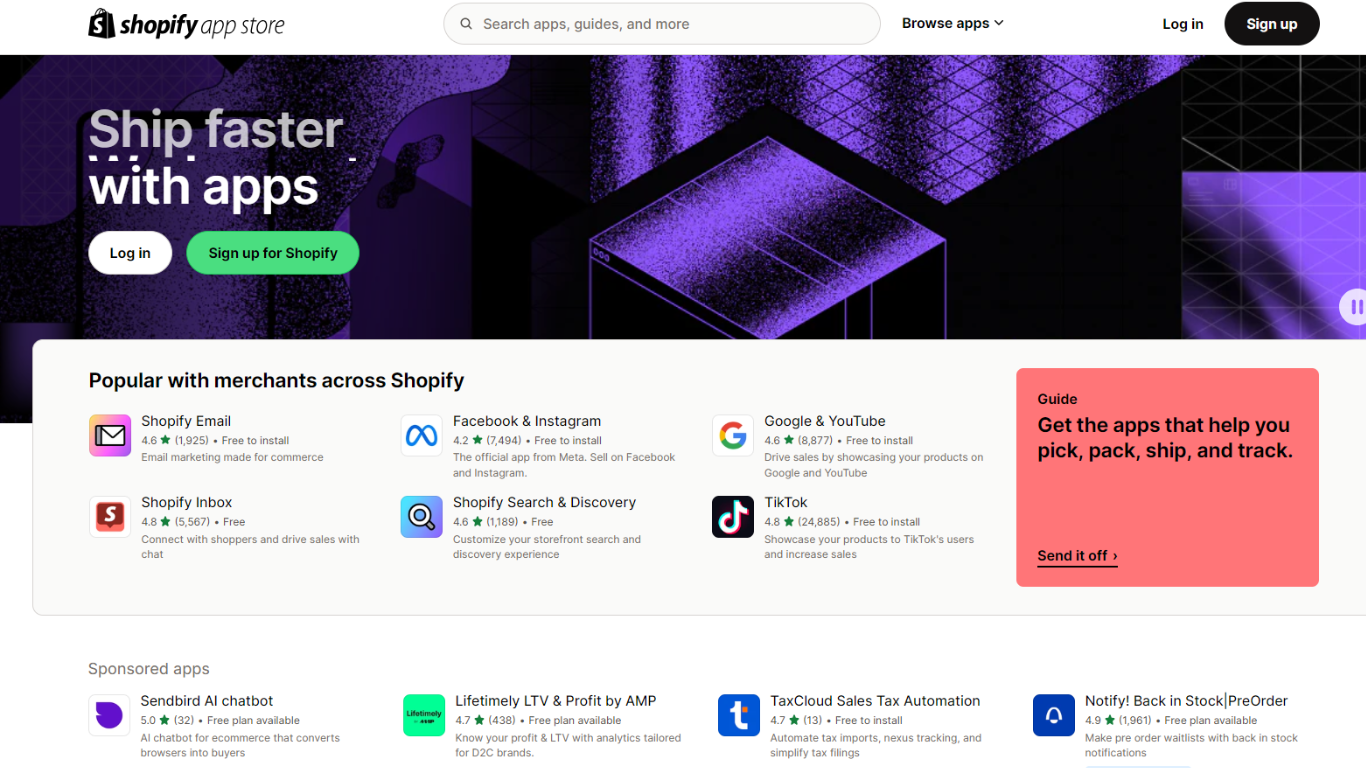The Shopify App Store is an important platform for developers to showcase their applications to a wide audience of merchants.
A well-executed Shopify app store listing can greatly improve your app’s visibility and increase its sales potential.

In this guide, you will learn about:
- Preparing your app for submission.
- Ensuring compliance with Shopify’s requirements.
- Integrating billing functionality using the Billing API.
- Developing a marketing strategy for your app launch.
- Navigating the review process effectively.
This comprehensive approach will help you understand the intricacies of Shopify app listing and increase your chances of success.
Step 1: Prepare Your App for Submission
Before you start the process of app listings on the Shopify App Store, it’s important to have a pre-submission checklist.
This will help you make sure that your essential app functionality is stable and fully developed.

Taking the time to prepare your application properly will increase your chances of getting approved and provide a better experience for users.
Required Components for a Successful Submission
To make the submission process easier, developers need to gather these important items:
- App Name: Choose a unique and descriptive name.
- Graphics: Create high-quality visuals, including:
- App Card
- Banner
- Icon
- Tagline: Develop a concise tagline that captures your app’s essence.
- Detailed Description: Write an informative description highlighting features and benefits.
- Comprehensive Documentation: Prepare installation guides and feature lists to assist users.
- Contact Information for Support Channels: Provide clear avenues for user inquiries or support requests.
- Demo or Beta Versions: Offer testing options to allow potential users to experience the app before full deployment.
Thorough preparation not only streamlines the submission process but also helps in establishing credibility with prospective users.
By focusing on these foundational aspects, you set the stage for a successful app listing on the Shopify App Store.
Step 2: Ensure Compliance with Shopify’s App Requirements
Compliance with Shopify’s quality standards is essential for developers aiming to list their apps successfully on the platform.
These standards ensure that all applications offer a consistent and positive user experience, which is critical for maintaining merchant trust and satisfaction.
Key elements of Shopify’s quality standards include:
- Functionality and Performance
- Apps must perform reliably across various devices and scenarios.
- Thorough testing is necessary to identify and resolve any bugs or performance issues before submission.
- Security Measures
- Implement robust security protocols to protect sensitive merchant data.
- Compliance with installation and setup protocols is crucial; this includes ensuring secure data transmission and storage practices.
Adhering to these requirements not only enhances the app’s appeal to potential users but also minimizes the risk of rejection during the apps review process.
Taking the time to align with Shopify’s expectations demonstrates professionalism and respect for merchants’ needs, laying a strong foundation for a successful app launch.
Step 3: Integrate Billing Functionality Using the Billing API
Integrating billing functionality is a critical step for any developer looking to monetize their app on the Shopify App Store.
The Billing API facilitates seamless transactions, allowing merchants to handle app charges directly through their existing Shopify invoices.
This integration simplifies the billing process, providing a streamlined experience for users.
Key Benefits of Using the Billing API:
- Simplified Transactions: Merchants can manage all payments from one dashboard, reducing friction and enhancing user satisfaction.
- Transparency: Customers receive clear invoicing through Shopify, fostering trust and credibility.
- Recurring Charges: The API supports various billing models, including one-time fees and recurring subscriptions, enabling flexibility in pricing strategies.
Steps to Integrate App Charges:
- Set Up Your Application: Ensure your app is configured correctly within the Shopify Partner Dashboard.
- Utilize API Endpoints: Implement necessary API endpoints for creating and managing charges.
- Test Thoroughly: Before launching, rigorously test the billing features to ensure proper functionality and user experience.
By successfully integrating the Billing API, developers not only enhance their app’s usability but also provide a smoother financial interaction for merchants.
This sets the stage for increased adoption and potential revenue growth within the Shopify ecosystem.
Step 4: Develop a Marketing Strategy to Support Your App Launch
Creating a comprehensive marketing strategy is crucial for your app’s success on the Shopify App Store.
A well-executed marketing plan can significantly enhance visibility and attract potential users.
Consider the following types of promotional materials to support your app launch:
- Press Releases: Craft compelling announcements highlighting your unique app features, benefits, and launch details. Distributing press releases through relevant channels can generate buzz and reach a wider audience.
- Social Media Posts: Leverage platforms like Twitter, Facebook, and Instagram to engage with potential users. Share eye-catching graphics, short videos demonstrating your app’s functionality, and customer testimonials to create interest.
- Email Newsletters: Utilize email campaigns to inform existing customers about your new app. Include links to the app listing and any promotional offers you may have during the launch period.
- Blog Posts: Write articles discussing the problem your app solves or providing tips related to its functionality. This can draw organic traffic and establish authority in your niche.
Integrating these promotional materials into your marketing plan fosters excitement around your example app launch while effectively reaching diverse merchant audiences.
Step 5: Navigate the Review Process with Shopify’s Specialists
The Shopify app review process is a critical phase in getting your app listed on the Shopify App Store.
After submission, your app will be evaluated by Shopify’s Apps Onboarding Specialists, who will assess its functionality, user experience, and adherence to platform guidelines.

During this evaluation, feedback will be provided to highlight areas for improvement. Addressing this feedback effectively can significantly increase your chances of a successful listing.
Here are some strategies to consider:
- Thoroughly App Review Feedback: Analyze the comments provided by the specialists. Identify specific aspects that require changes or enhancements.
- Prioritize Improvements: Focus on major issues first, such as functionality or security concerns. Minor aesthetic suggestions can be handled afterward.
- Communicate Clearly: If a piece of feedback is unclear, do not hesitate to reach out for clarification. Establishing open communication can aid in understanding expectations.
- Document Changes: Keep track of modifications made in response to feedback. This practice not only helps in future submissions but also demonstrates your commitment to quality.
Following these strategies will not only improve your app but also build credibility with Shopify’s specialists, paving the way for a smoother app review process and successful listing in the Shopify App Store.
Step 6: Post-Launch Monitoring and Updates
After your app is live on the Shopify App Store, the work is far from over.
Maintaining a successful Shopify app requires continuous monitoring, collecting feedback, and regularly updating your app to meet merchant needs and stay competitive.

Key Actions for Post-Launch Success:
- Monitor User Feedback: Keep an eye on user app reviews and ratings to understand how merchants are interacting with your app. Address any concerns or issues promptly to maintain a positive reputation.
- Track Performance Metrics: Use analytics tools to monitor key metrics such as app usage, installation rates, and churn. Identifying trends early allows you to make necessary adjustments to improve user experience.
- Update Your App Regularly: Periodic updates are essential to address bugs, improve functionality, and introduce new features. Regular updates show merchants that your app is actively supported and evolving with their needs.
- Engage with the Merchant Community: Stay connected with merchants through support channels and forums. Engaging with users directly can foster loyalty and generate useful insights for future improvements.
- Adjust Marketing Efforts: After launch, continue promoting your app through marketing strategies like email campaigns, social media outreach, and collaborations with influencers or other Shopify partners.
Why It Matters:
Continuous monitoring, timely updates, and consistent engagement help build long-term trust with merchants and ensure your app remains relevant in a competitive marketplace.
By being proactive after launch, you can minimize churn, enhance user satisfaction, and optimize your app for ongoing success.
Common Mistakes to Avoid During the App Listing Process
Developers should be aware of several common pitfalls in app’s listing that can lead to rejection from the Shopify App Store.

Understanding these mistakes is crucial for a successful submission.
1. JWT Authentication Errors
Failing to implement JSON Web Token (JWT) authentication can hinder the security of your app. Ensure that your app correctly validates the JWT token to maintain user data integrity.
2. Billing API Mistakes
Neglecting to integrate the Billing API properly can result in payment processing issues. Double-check that all billing functionality aligns with Shopify’s requirements to streamline merchant transactions.
3. Incomplete Documentation
Submissions lacking comprehensive documentation, such as installation guides or feature descriptions, may confuse users and lead to rejections. Provide detailed and clear instructional material.
4. Poor Quality Graphics
Low-resolution images or poorly designed graphics can negatively impact first impressions. Invest time in creating high-quality visuals that effectively represent your app.
5. Ignoring User Experience Standards
Not adhering to Shopify’s quality standards for functionality and performance can result in rejection. Prioritize user experience by conducting thorough testing before submission.
By avoiding these common mistakes, developers enhance their chances of a successful app listing on the Shopify App Store while ensuring a smooth experience for merchants.
Optimizing Your App Listing Content for Maximum Visibility
Enhancing your app’s visibility on the Shopify App Store relies heavily on the content of your listing.
Key aspects to consider include:
1. High-Quality Media
Incorporate visually appealing images and videos that showcase your app’s features and user interface. High-quality media can capture the attention of potential users, making them more inclined to explore further.
tilize screenshots that highlight unique functionalities and add a demo video to provide a walkthrough of the app experience.
2. Clear Descriptions
Craft concise yet informative descriptions that focus on your app’s benefits without referencing competitors.
Use straightforward language that communicates what makes your app valuable to merchants.
Consider employing bullet points to break down features, making it easier for users to digest information quickly.
3. Optimized Content
Implement SEO strategies by integrating relevant keywords naturally throughout your description. This approach enhances searchability within the App Store, increasing the likelihood of appearing in search results.
Analyze competitor listings for inspiration while maintaining originality in your content.
Focusing on these elements will significantly boost your app’s chances of standing out in a crowded marketplace, attracting more potential users eager to improve their Shopify experience.
Expanding Your Reach with Multilingual Listings
Providing multilingual listings can significantly enhance the visibility and accessibility of your app on the Shopify App Store.
As you cater to diverse merchant audiences, consider the following benefits:
- Increased Reach: Translating your app listing into multiple languages allows you to connect with merchants globally, broadening your potential customer base.
- Improved User Experience: Merchants are more likely to engage with content that is presented in their native language. This fosters a sense of trust and comfort, leading to higher conversion rates.
- Competitive Advantage: Many apps may overlook this aspect. By offering translated content, you distinguish your app from competitors who only present information in English, attracting users who prefer localized options.
- Enhanced Accessibility: Merchants from various linguistic backgrounds will find your app more approachable and easier to understand, promoting a better overall experience.
Implementing these multilingual listings requires careful attention to detail. Ensure that translations are accurate and culturally relevant.
Utilizing professional translation services can prevent misunderstandings and ensure clarity in your messaging.
Tailoring your app’s presence for different markets not only enhances user engagement but also maximizes its potential for success within the Shopify ecosystem.
Dario`s Conclusion
A successful app listing on the Shopify App Store depends on paying attention to detail and following best practices.
Developers should:
- Follow submission guidelines carefully
- Focus on delivering a stable, finished product
- Offer thorough documentation and support options
By prioritizing quality experiences throughout the entire app listing process, developers can greatly improve their app’s visibility and sales potential.
Remember, creating an appealing presence in the App Store isn’t just about meeting requirements; it’s also about providing value to merchants.
The tips shared in this in this blog post serve as a roadmap for achieving that goal. Use these strategies to set your Shopify app up for success.
Frequently Asked Questions: Shopify App Listing
What is the significance of the Shopify App Store for developers?
The Shopify App Store is crucial for developers as it enhances app visibility and sales potential.
A successful Shopify app listing can significantly impact how well your app performs in the marketplace.
What are the essential components required for a successful app submission?
To ensure a successful submission, your app must include a stable product, an app name, graphics (app card, banner, icon), a tagline, a detailed description, comprehensive documentation (installation guide, features), contact information for support channels, and demo or beta versions for testing.
How can I ensure my app complies with Shopify’s quality standards?
To comply with Shopify’s quality standards, focus on providing consistent functionality and performance.
Implement necessary security measures to protect merchant data and adhere to installation/setup protocols.
Why is integrating the Billing API important for my app?
Integrating the Billing API is significant for facilitating seamless transactions within your app.
It allows you to manage app charges effectively and simplifies billing processes for merchants.
What common mistakes should I avoid during the app listing process?
Common pitfalls include JWT authentication errors and mistakes related to the Billing API.
It’s essential to thoroughly review your submission to avoid these issues that can lead to rejection from the Shopify App Store.



